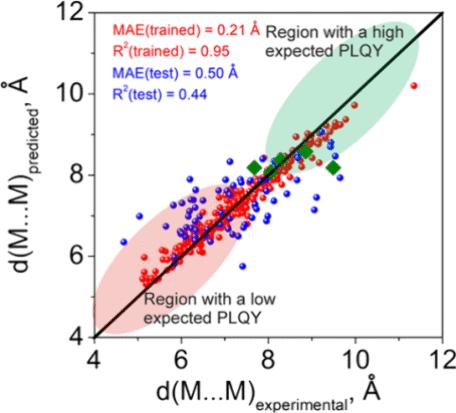筛选高性能混合卤化物闪烁体:一个综合分析和预测模型
IF 7
2区 材料科学
Q2 CHEMISTRY, PHYSICAL
引用次数: 0
摘要
应用机器学习模型预测有机-无机杂化金属卤化物(OIMHs)的闪烁性能,重点关注其光致发光量子产率(PLQY)。随机森林和决策树算法确定了有机分子中影响金属离子间M···M距离和相关PLQY值的最关键结构参数,最佳距离约为8 Å,与发光效率的提高相关。通过几种OIMH化合物的合成实验验证了这一预测,表明预测值和测量值之间的PLQY值非常一致。机器学习方法不仅能够筛选有效的化合物,而且加深了对结构因素(如有机分子的结构)如何控制闪烁特性的理解。这些发现强调了机器学习在加速开发性能更高的下一代发光材料方面的潜力,为未来的材料设计和优化提供了强大的工具。本文章由计算机程序翻译,如有差异,请以英文原文为准。

Screening High-Performance Hybrid Halides Scintillators: A Comprehensive Analysis and Prediction Model
Machine learning models were applied to predict the scintillation performances of organic–inorganic hybrid metal halides (OIMHs), focusing on their photoluminescent quantum yield (PLQY). Random Forest and Decision Tree algorithms identified the most critical structural parameter of organic molecules influencing the M···M distance between metal ions and correlated PLQY value, with an optimal distance of approximately 8 Å correlating with enhanced luminescence efficiency. This prediction was experimentally validated through the synthesis of several OIMH compounds, demonstrating strong agreement between predicted and measured PLQY values. The machine learning approach not only enabled the screening of efficient compounds but also deepened the understanding of how structural factors, such as the structure of organic molecules, govern scintillation properties. These findings underscore the potential of machine learning in accelerating the development of next-generation luminescent materials with improved performance, offering a powerful tool for future material design and optimization.
求助全文
通过发布文献求助,成功后即可免费获取论文全文。
去求助
来源期刊

Chemistry of Materials
工程技术-材料科学:综合
CiteScore
14.10
自引率
5.80%
发文量
929
审稿时长
1.5 months
期刊介绍:
The journal Chemistry of Materials focuses on publishing original research at the intersection of materials science and chemistry. The studies published in the journal involve chemistry as a prominent component and explore topics such as the design, synthesis, characterization, processing, understanding, and application of functional or potentially functional materials. The journal covers various areas of interest, including inorganic and organic solid-state chemistry, nanomaterials, biomaterials, thin films and polymers, and composite/hybrid materials. The journal particularly seeks papers that highlight the creation or development of innovative materials with novel optical, electrical, magnetic, catalytic, or mechanical properties. It is essential that manuscripts on these topics have a primary focus on the chemistry of materials and represent a significant advancement compared to prior research. Before external reviews are sought, submitted manuscripts undergo a review process by a minimum of two editors to ensure their appropriateness for the journal and the presence of sufficient evidence of a significant advance that will be of broad interest to the materials chemistry community.
 求助内容:
求助内容: 应助结果提醒方式:
应助结果提醒方式:


